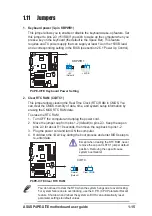
ASUS P4PE-X/TE motherboard user guide
1-5
ATX 12V connector. This power connector connects the 4-pin 12V plug from
the ATX 12V power supply.
CPU socket. A 478-pin surface mount, Zero Insertion Force (ZIF) socket for
the Intel
®
Pentium
®
4 Processor, with 800/533/400 MHz system bus that allows
6.4GB/s, 4.3GB/s, and 3.2GB/s data transfer rates, respectively.
North bridge controller. The Intel
®
845PE Memory Controller Hub (MCH)
provides the processor interface with 533/400 MHz frequency, system
memory interface at 333/266MHz operation, and 1.5V AGP interface that
supports AGP 2.0 specification including 4X Fast Write protocol. The MCH
interconnects to the south bridge ICH4 via the Intel
®
proprietary Hub Interface.
DDR DIMM sockets. These three 184-pin DIMM sockets support up to 2GB
system memory using unbuffered non-ECC PC3200*/2700/2100/1600 DDR
DIMMs. (
*Overclocking mode
)
ATX power connector. This 20-pin connector connects to an ATX +12V
power supply. The power supply must have at least 1A on the +5V standby
lead (+5VSB).
Floppy disk connector. This connector accommodates the provided ribbon
cable for the floppy disk drive. One side of the connector is slotted to prevent
incorrect insertion of the floppy disk cable.
IDE connectors. These dual-channel bus master IDE connectors support
Ultra DMA100/66, PIO Modes 3 & 4 IDE devices. Both the primary (blue) and
secondary (black) connectors are slotted to prevent incorrect insertion of the
IDE ribbon cable.
South bridge controller. The fourth-generation Intel I/O Controller Hub
(ICH4) is a subsystem that integrates various I/O functions including 2-channel
ATA100 bus master IDE controller, up to six USB 2.0/1.1 ports, I/O APIC,
SMBus 2.0 controller, LPC interface, AC’97 2.2 interface, and PCI 2.2
interface. The ICH4 also contains the necessary arbitration and buffering for
efficient utilization of these interfaces.
Flash ROM. This 2Mb firmware contains the programmable BIOS program.
Standby power LED. This LED lights up if there is a standby power on the
motherboard. This LED acts as a reminder to turn off the system power before
plugging or unplugging devices.
ASUS ASIC. This chip performs multiple system functions that include
hardware and system voltage monitoring, IRQ routing, among others.
Super I/O controller. This Low Pin Count (LPC) interface provides the
commonly used Super I/O functionality. The chipset supports a high-
performance floppy disk controller for a 360K/720K/1.44M/2.88M floppy disk
drive, a multi-mode parallel port, two standard compatible UARTs, and a Flash
ROM interface.
PCI slots. These six 32-bit PCI 2.2 expansion slots support bus master
PCI cards like SCSI or LAN cards with 133MB/s maximum throughput.
11
12
13
10
9
8
7
6
5
4
3
2
1














































